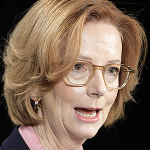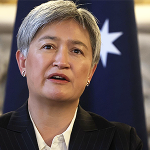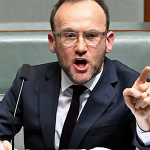In 2024, China exported three times more to the US than the US did to China, and President Donald Trump’s aim is to get this trade balance down to zero. On ‘Liberation Day’, Wednesday 2 April, Trump announced that Chinese goods coming into the US would now have an additional tariff of 34 per cent imposed on them, added to an extra 20 per cent imposed earlier this year. This means that those goods are now subject to an overall rate of 54 per cent. China has now lodged a complaint at the World Trade Organisation, declaring: ‘This practice of the US is not in line with international trade rules, seriously undermines China’s legitimate rights and interests, and is a typical unilateral bullying practice.’
Can China force the US to change direction? It’s unlikely in the short term. Jude Blanchette, director of the Rand China Research Centre in Washington told me that ‘the Chinese counter-tariffs in themselves are unlikely to force a course-correction from the Trump administration, especially as Trump is clearly less bothered by market movements than he was during his first term.’
Beijing’s sharp language, there’s wariness and uncertainty about American intentions. Things seem to be moving in American China policy, but not all in the same direction. According to some reports, a deal had finally been agreed with Bytedance, the Chinese owner of TikTok, to sell the wildly successful social media app to an American buyer. When the tariffs were announced on Wednesday, the deal was called off by Beijing. This was unsurprising: most diplomats would realise that China could hardly make a major concession on TikTok that looked as if it had been forced on them by US tariffs. But there was also wider confusion about what these contradictory events said about the connections between policymaking on trade issues and security.
Beijing may also be scratching its head at mixed signals on another issue central to its relationship with the US: Taiwan. The Financial Times reported that Joseph Wu, Taiwan’s top security official, was due in Washington last weekend for talks. The talks, referred to as the
‘special channel’, have been public knowledge since 2021, but are generally kept low-key to avoid provoking Beijing. Yet this meeting comes on the same weekend that several senior US figures involved with national security policies, including on China specifically, have been fired by the administration. It’s not clear yet whether their views on China and Russia contributed to their axing, but it leaves Washington’s attitude toward China still unclear. Discussions in policy circles on the direction of travel range from the possibility of a confrontation over Taiwan to a ‘grand bargain’ which divides up the world, with the western hemisphere under US influence and the eastern shaped by Beijing.
Meanwhile, China’s policymakers are still puzzled by a US administration dissimilar to any other they’ve encountered. As a result, they have restrained their public pronouncements, sticking to declarations that sound fierce but are boilerplate in language. However, Beijing is preparing its own shifts in policy. In March, EU trade chief Maros Sefcovic met Chinese vice-premier He Lifeng in Beijing; the latter declared that they must ‘jointly resist unilateralism and protectionism to protect the multilateral trading system.’ Ironically, Hungary’s prime minister Viktor Orban, one of the closest figures culturally to the new US administration, is also one of the most enthusiastic advocates for closer economic ties between China and the EU.
Other major liberal economies, including the UK and Australia, are also being pushed to seek new economic opportunities from Chinese investment. Both countries are deeply wary of the security implications of closeness to China in areas of sensitive technology, but also know that if trade with the US is now in danger, China is one of the few large markets where there might be a chance of expansion. ‘China’s response,’ Blanchette notes, ‘if coupled with strong reactions from the EU and other key economies, might in the aggregate effect so much pain on the US economy that Trump is forced to declare his tariffs an early success and find a quick path to de-escalation.’
China’s economy is still underperforming, and remains highly dependent on exporting. Being forced to charge American suppliers and consumers more for their goods will undoubtedly cause short-term pain for China’s economy, but in the years since the first Trump administration, China has leaned into policies of ‘self-reliance’ (zili gengsheng), and Xi Jinping and the politburo are likely to have calculated that they can make their way through it. In fact, it might stimulate a policy that China’s economists have been advocating for years: an encouragement to Chinese savers to spend more and stimulate domestic consumption. It would be ironic if one effect of the tariff policy was to prevent Chinese exports growing and instead force Beijing to rebalance its economy to make it more sustainable over the medium term – but everything is possible.








